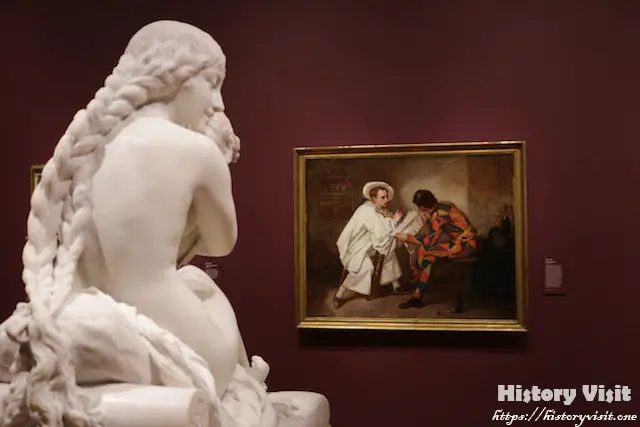Venus and Cupid (Love Forgiven) 1888: Exploring the Tale of Love and Redemption

Introduction:
In the realm of art, few stories are as timeless and captivating as that of Venus and Cupid. Among the many depictions of this legendary tale, one stands out with its evocative portrayal of love and forgiveness – “Venus and Cupid (Love Forgiven) 1888.” Let’s embark on a journey to uncover the secrets behind this exquisite masterpiece and delve into the depths of its emotional resonance.
Historical and Cultural Context:
Painted in 1888 by the renowned artist, Sir Lawrence Alma-Tadema, “Venus and Cupid (Love Forgiven)” captures the essence of classical mythology and the enduring theme of love’s transformative power. Alma-Tadema, known for his meticulous attention to detail and mastery of the neoclassical style, imbues this work with a sense of timeless beauty and emotional depth. Born in the Netherlands but later residing in England, Alma-Tadema drew inspiration from both classical antiquity and the Victorian era, blending elements of ancient myth with contemporary aesthetics.
Descriptive Language:
As you gaze upon “Venus and Cupid (Love Forgiven),” you are immediately drawn into a world of ethereal beauty and profound emotion. The figures of Venus and Cupid are rendered with exquisite grace and sensitivity, their expressions conveying a myriad of emotions – from longing and remorse to tender forgiveness. Venus, the goddess of love, gazes upon Cupid with compassion and understanding, her gentle touch symbolizing the act of forgiveness. Cupid, the mischievous god of desire, bows his head in repentance, his wings drooping with remorse. The delicate play of light and shadow further enhances the scene, casting a soft glow upon the figures and imbuing the painting with a sense of otherworldly serenity.

Personal Anecdotes or Testimonials:
For centuries, viewers have been captivated by the haunting beauty of “Venus and Cupid (Love Forgiven).” Countless admirers have found solace and inspiration in its timeless depiction of love’s redemptive power. Whether displayed in grand museums or cherished in private collections, this masterpiece continues to resonate with audiences around the world, inviting them to contemplate the mysteries of the human heart. Critics and art historians alike have praised Alma-Tadema’s skillful execution and emotive storytelling, hailing “Venus and Cupid (Love Forgiven)” as a triumph of neoclassical artistry.
Cultural Insights:
At its core, “Venus and Cupid (Love Forgiven)” reflects the enduring fascination with classical mythology and its relevance to the human experience. Through the lens of mythological allegory, Alma-Tadema explores themes of love, forgiveness, and redemption – themes that resonate across cultures and generations, transcending the boundaries of time and space. The enduring popularity of Venus and Cupid’s story speaks to its universal appeal, transcending cultural differences and resonating with audiences of all backgrounds.
Hidden Gems and Unique Features:
While “Venus and Cupid (Love Forgiven)” is celebrated for its beauty and emotional depth, it also contains hidden symbolism and allegorical elements that invite deeper interpretation. From the subtle placement of objects to the intricate details of the background scenery, every element of the painting contributes to its rich tapestry of meaning, offering new insights with each viewing. Scholars have speculated about the significance of various motifs, such as the roses symbolizing love and the doves representing peace. These hidden gems add layers of complexity to the painting, encouraging viewers to explore its depths and unravel its mysteries.
Visuals:
Accompanying the article are high-resolution images of “Venus and Cupid (Love Forgiven),” allowing readers to immerse themselves in the exquisite beauty of this timeless masterpiece. Through detailed close-ups and panoramic views, readers can appreciate the intricate brushwork and subtle nuances of Alma-Tadema’s composition. These visuals enhance the reader’s understanding and appreciation of the painting, bringing its timeless beauty to life on the page.

Engaging Narration:
Through a compelling narrative structure, readers are transported to the world of “Venus and Cupid (Love Forgiven),” where they witness the unfolding drama of love and forgiveness. Drawing upon historical context, artistic analysis, and personal reflection, the article invites readers on a journey of discovery and contemplation, encouraging them to explore the deeper layers of meaning within the painting. By weaving together storytelling and scholarship, the article creates a compelling narrative experience that resonates with readers on an emotional and intellectual level.
Practical Tips:
For art enthusiasts eager to experience “Venus and Cupid (Love Forgiven)” in person, the article provides practical tips for visiting museums or galleries where the painting may be displayed. Additionally, readers are encouraged to explore related works by Alma-Tadema and other artists inspired by classical mythology. By offering practical guidance and suggestions for further exploration, the article empowers readers to deepen their understanding and appreciation of this timeless masterpiece.
Call to Action:
In closing, the article encourages readers to reflect on the timeless themes of love and forgiveness depicted in “Venus and Cupid (Love Forgiven).” Whether through further exploration of art history or personal contemplation of the painting’s significance, readers are invited to engage with the work on a deeper level, discovering new layers of meaning with each encounter. As they embark on their own journey of discovery, readers are reminded of the enduring power of art to inspire, enlighten, and transform our understanding of the world around us.


